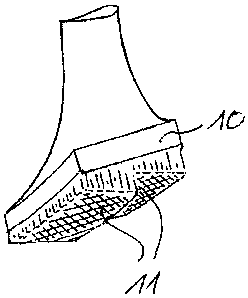Some of the information on this Web page has been provided by external sources. The Government of Canada is not responsible for the accuracy, reliability or currency of the information supplied by external sources. Users wishing to rely upon this information should consult directly with the source of the information. Content provided by external sources is not subject to official languages, privacy and accessibility requirements.
Any discrepancies in the text and image of the Claims and Abstract are due to differing posting times. Text of the Claims and Abstract are posted:
| (12) Patent Application: | (11) CA 2637291 |
|---|---|
| (54) English Title: | GUIDE BLADE SEGMENT OF A GAS TURBINE AND METHOD FOR ITS PRODUCTION |
| (54) French Title: | SEGMENT D'AUBE DE GUIDAGE D'UNE TURBINE A GAZ ET PROCEDE POUR SA FABRICATION |
| Status: | Deemed Abandoned and Beyond the Period of Reinstatement - Pending Response to Notice of Disregarded Communication |
| (51) International Patent Classification (IPC): |
|
|---|---|
| (72) Inventors : |
|
| (73) Owners : |
|
| (71) Applicants : |
|
| (74) Agent: | MARKS & CLERK |
| (74) Associate agent: | |
| (45) Issued: | |
| (86) PCT Filing Date: | 2007-01-19 |
| (87) Open to Public Inspection: | 2007-08-02 |
| Examination requested: | 2012-01-18 |
| Availability of licence: | N/A |
| Dedicated to the Public: | N/A |
| (25) Language of filing: | English |
| Patent Cooperation Treaty (PCT): | Yes |
|---|---|
| (86) PCT Filing Number: | PCT/DE2007/000097 |
| (87) International Publication Number: | DE2007000097 |
| (85) National Entry: | 2008-07-16 |
| (30) Application Priority Data: | ||||||
|---|---|---|---|---|---|---|
|
The invention relates to a guide blade segment of a gas turbine, having at
least one guide blade and having an inner cover band (10) assigned to the
radially inner end of the or each guide blade. According to the invention, an
integral constituent part of the inner cover band (10) of the guide blade
segment is a sealing element (11) which serves to seal a radially inner gap
between the guide blade segment and a gas turbine rotor.
L'invention concerne un segment d'aube de guidage pour turbine à gaz, qui présente au moins une aube de guidage et une bande intérieure de recouvrement (10) associée à l'extrémité située radialement à l'intérieur de la ou des aubes de guidage. Selon l'invention, un élément d'étanchéité (11) qui assure l'étanchéité d'un interstice radial intérieur entre le segment d'aube de guidage et le rotor de la turbine à gaz fait partie intégrante de la bande intérieure de recouvrement (10) du segment d'aube de guidage.
Note: Claims are shown in the official language in which they were submitted.
Note: Descriptions are shown in the official language in which they were submitted.

2024-08-01:As part of the Next Generation Patents (NGP) transition, the Canadian Patents Database (CPD) now contains a more detailed Event History, which replicates the Event Log of our new back-office solution.
Please note that "Inactive:" events refers to events no longer in use in our new back-office solution.
For a clearer understanding of the status of the application/patent presented on this page, the site Disclaimer , as well as the definitions for Patent , Event History , Maintenance Fee and Payment History should be consulted.
| Description | Date |
|---|---|
| Application Not Reinstated by Deadline | 2014-01-21 |
| Time Limit for Reversal Expired | 2014-01-21 |
| Deemed Abandoned - Failure to Respond to Maintenance Fee Notice | 2013-01-21 |
| Letter Sent | 2012-02-01 |
| Request for Examination Requirements Determined Compliant | 2012-01-18 |
| All Requirements for Examination Determined Compliant | 2012-01-18 |
| Request for Examination Received | 2012-01-18 |
| Inactive: Office letter | 2011-03-23 |
| Inactive: Office letter | 2009-02-02 |
| Letter Sent | 2009-02-02 |
| Inactive: Single transfer | 2008-12-12 |
| Correct Applicant Request Received | 2008-11-10 |
| Inactive: Cover page published | 2008-11-06 |
| Inactive: Notice - National entry - No RFE | 2008-10-22 |
| Inactive: First IPC assigned | 2008-09-05 |
| Application Received - PCT | 2008-09-04 |
| National Entry Requirements Determined Compliant | 2008-07-16 |
| Application Published (Open to Public Inspection) | 2007-08-02 |
| Abandonment Date | Reason | Reinstatement Date |
|---|---|---|
| 2013-01-21 |
The last payment was received on 2012-01-18
Note : If the full payment has not been received on or before the date indicated, a further fee may be required which may be one of the following
Patent fees are adjusted on the 1st of January every year. The amounts above are the current amounts if received by December 31 of the current year.
Please refer to the CIPO
Patent Fees
web page to see all current fee amounts.
| Fee Type | Anniversary Year | Due Date | Paid Date |
|---|---|---|---|
| Basic national fee - standard | 2008-07-16 | ||
| MF (application, 2nd anniv.) - standard | 02 | 2009-01-19 | 2008-07-16 |
| Registration of a document | 2008-12-12 | ||
| MF (application, 3rd anniv.) - standard | 03 | 2010-01-19 | 2009-12-22 |
| MF (application, 4th anniv.) - standard | 04 | 2011-01-19 | 2010-12-29 |
| Request for examination - standard | 2012-01-18 | ||
| MF (application, 5th anniv.) - standard | 05 | 2012-01-19 | 2012-01-18 |
Note: Records showing the ownership history in alphabetical order.
| Current Owners on Record |
|---|
| MTU AERO ENGINES GMBH |
| Past Owners on Record |
|---|
| CLAUS MUELLER |
| KARL-HEINZ DUSEL |
| REINHOLD MEIER |
| ROLAND HUTTNER |